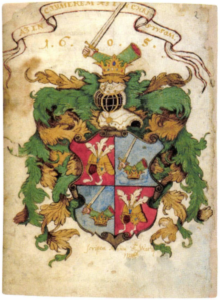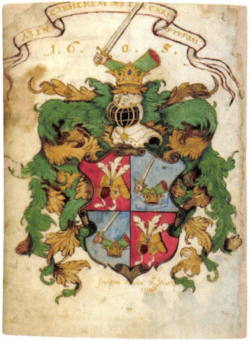Wathay Ferenc (1568- after 1609)
Wathay Ferenc was not just a brave soldier but also a poet and an artist, the author of the famous Wathay Codex, a hand-written and nicely painted book in which he described the history of his captivity in Ottoman hands.

Wathay Ferenc was born around 24 September 1568. We do not know the day exactly, even though he mentions it a bit obscurely in his autobiography. He wrote that he was born after the fall of Szigetvár castle at the end of Saint Michail’s month in 1568. He added that he was born in Nagyvág in the “new house” overlooking the Rába River…More exactly, it was the stately home of their family in Sopron County in Vág. His father was Wathay Lőrinc, the captain of Csesznek castle, his mother was Csaby Klára.

www.varlexikon.hu

Ferenc went to school in Németújvár and in Sopron, then began his military career in Tihany castle in 1584. After this, he served in several castles including Csesznek and Győr castles. He took part in many battles and sieges of the 15-Year-War, like in the sieges of Székesfehérvár in 1593, in Győr in 1594, in Veszprém in 1598, and in Székesfehérvár again in 1601. You can read the entire summary of the 15-Yer-War on my page, the series can be found here:
https://www.hungarianottomanwars.com/chronologie/the-fifteen-year-war-series-1591-1606/

Ferenc wrote in his work that he wanted to serve Nádasdy Ferenc (the Black Bey) as a lieutenant in the year of the taking of Koppány castle in 1587 but Nádasdy did not give him the job of leading 100 Hussars in Bodonhely because there was “no vacancy”. Wathay became so disappointed that later on, he refused to serve Nádasdy, even though the famous lord asked for it. The next time, Wathay Ferenc appeared in Óvár castle as the commander of 25 Hussars in 1595.

Then, he reconsidered his opinion and took the job offered by Nádasdy in Sárvár castle. His commander was Maróthy Mihály, and Wathay led 50 Hussars as a lieutenant. We find him in Ppa castle in 1597, and he was taken in captivity by the rebelling Walloon mercenaries of Pápa castle in 1600. The troops of Nádasdy freed him when they took Pápa by siege. Here is more about the mutiny of these soldiers:

After the siege, he went to Sárvár castle where he stayed for a few months. Wathay Ferenc married Ládonyi Anna in 1600 but the plague killed her in the same year. (Please, note that I use the Oriental name order for Hungarians where family names come first.) His second wife was Vághy Zsuzsanna, his distant relative. Unfortunately, they could not spend a long time together because he was appointed as the Vice-Captain of (Székes)Fehérvár castle and the Ottomans took the castle at the end of August 1602. Wathay was wounded and taken into Ottoman captivity.

You can read the history of the siege of Fehérvár on my page:
He was taken to Temesvár (Timișoara / Temeschburg), then to Nándorfehérvár (Belgrade) castle. He tried to escape several times but he was always caught, and finally, he had to be closed into the dungeon of the Yedikule in Istanbul. During his captivity, he wrote his famous book which contained the story of his life, along with religious songs. He illustrated it with wonderful watercolor pictures, the picture of Nándorfehérvár is among them, it is the third earliest illustration of the castle.

It is thought that he was released in 1606 when the Ottomans and the Imperials signed the Treaty of Zsitvatorok and exchanged their prisoners of war as a result of it. We know that he sent a letter of request in July 1606 to the Military Court, asking for his missing pay regarding his service in Székesfehérvár castle. He became the commander of 50 Hussars in 1607 in Győr castle, then the king appointed him as the castellan of Csesznek castle in 1609. The last thing we know about him is that the king appointed a new captain to Csesznek Castle in October 1609. There are no further sources about his life after this, so we do not know whether he died or was given another post.

You can read the famous book online here:
Dear Readers, I can only make this content available through small donations or by selling my books or T-shirts.
If you like my writings, please feel free to support me with a coffee here:
You can check out my books on Amazon or Draft2Digital, they are available in hardcover, paperback, or ebook:
https://www.amazon.com/dp/198020490X
or at https://books2read.com/b/boYd81


My work can also be followed and supported on Patreon: http://Become a Patron!

Here are a few pictures of the Wathay Codex:




















